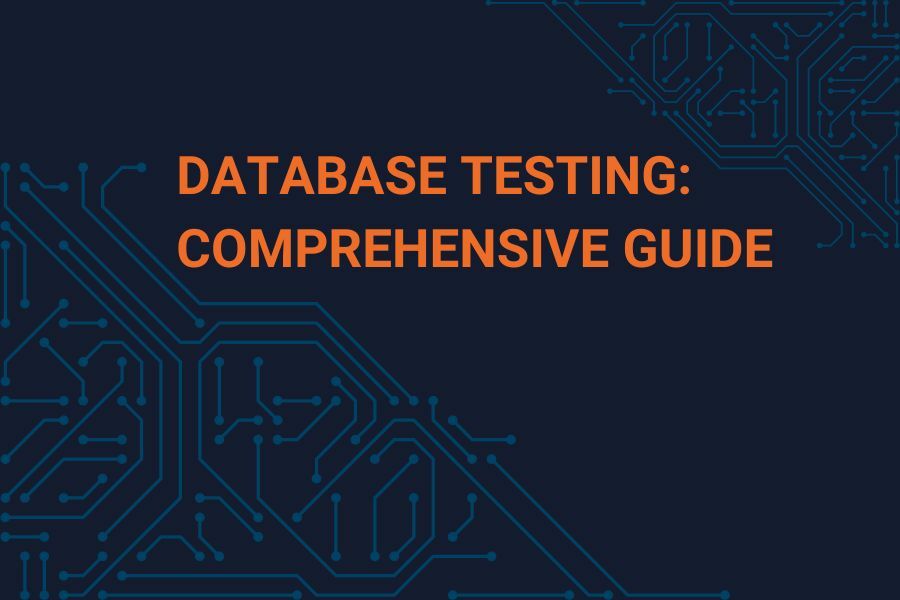No matter how reliable and secure your database may seem, it needs to be periodically and proactively tested. Otherwise, you may encounter quite unpleasant surprises:
● Data inconsistencies.
● Transaction errors.
● Faulty operations.
● Leakage of sensitive information.
● Failure of the entire IT product, including the server side.
These reasons compel IT teams to increasingly focus on DB testing.
At first glance, it may seem that there is nothing too complex or important in this process. Rest assured, the quality, stability, and security of your digital solution depend on testing your data systems.
Next, you’ll learn from DBServ experts what database testing is, its subtypes, key focus points, and its overall role in the viability of a digital product.
What is Database Testing?
In short, database testing is a set of mechanics and operations conducted by responsible IT personnel within both the development and maintenance framework of an application.
Overall, database testing can be classified as the process of checking one of the components of the server side for the presence of:
➡️ Inconsistent data sets.
➡️ Unrelated cells in the structure.
➡️ Information processing errors.
➡️ Weak points in the database architecture.
➡️ Issues with multitasking.
➡️ Components that reduce operational performance.
➡️ Critical vulnerabilities.
Therefore, you must continually conduct database testing to ensure maximum performance and functional operability and validate data sets for your IT solution.
Why Database Testing is Important?
As mentioned above, the importance of database testing lies in the ability to detect and rectify issues with your digital product in a timely manner. But that’s not all.
The importance of database testing is underscored by the fact that the proper functioning of the application’s server-side (or website or other types of solutions) depends precisely on how its internal data exchange occurs.
For example, if we look at a typical banking application, we’ll see a key function: transaction processing. So, if you don’t conduct proper database testing, you’ll face negative consequences:
● Debiting larger amounts during transactions.
● Query processing errors.
● Trigger malfunctions.
● System failures when checking for correct information input.
● Low query processing speed.
In reality, there could be many more problems because, without proper DB testing, your system may simply not function as intended. That’s why you need to test it with different tools and types of database testing.
Types of Database Testing
Interestingly, DB testing conceptually does not differ from other types of QA. You still need to choose the type of testing, create test cases, and determine the data sets by which the database will be tested.
Thus, we can rephrase the definition of what is database testing as a standard QA process but specifically oriented towards test database.
Nevertheless, the number of testing types is limited and boils down to:
✅ Structural testing.
✅ Functional testing.
✅ Non-functional testing.
These are three key types of tests that you should conduct proactively to prevent problems with your IT solution. There are other methods of database testing, but these mentioned ones play the most important role. That’s why today we’ll focus on them.
Structural Testing
This type of database testing covers, in particular, the server-side component, which the end-user does not have access to. In short, the following elements are checked here:
● Schema testing. This involves checking formats and structures for consistency and compatibility between the Back-End and Front-End.
● Table testing. This verifies data compatibility between tables and interfaces, both user-facing and within the database management system.
● Key and index testing. This ensures the linkage between internal and external containers, clusters, etc.
● Stored procedure testing. This examines the behavior of the database and its functionality in a broad sense.
● Trigger testing. This assesses the operational part of the database, its response to commands through the database management system, etc.
● Database server testing. This evaluates the working environment, its security, stress resilience, and the reliability of communication channels.
Thus, you can test database and address a wide range of problems directly related to architecture.
Functional Testing
This type of database testing aims to determine whether the system operates correctly and identifies operational issues, data inconsistencies, and more.
The critical areas of verification here are:
● Data integrity and consistency testing. This involves ensuring that information is logically arranged and well-structured.
● Authorization verification. It checks whether the system accepts correct and incorrect user data when connecting to the platform.
Stress resilience, encryption, and the overall security level of the server-side and, specifically, the database management system (DBMS) of the IT solution are simultaneously evaluated.
Non-functional Testing
When you test database, you need to pay attention to its operational component and several other parameters. These include:
➡️ Risk assessment. This refers to the system’s responsiveness to stimuli (commands, breaches, etc.).
➡️ Hardware requirements. Assessing the capacity of hardware and its restructuring in an optimal configuration.
➡️ Load potential. Checking how much and how often the system can process transactions concurrently and sequentially.
➡️ System stress resilience. Generating peak loads to test the system’s reaction.
➡️ Logical behavior of the DBMS and DB. Essentially, this is UX testing, which shows how user-friendly the system is.
You will need additional tools and components to test IT solutions with all these types of testing.
Key Components of Database Testing
Testing covers all critical elements of the database, namely:
● Database Schema.
● Transactions.
● Store Procedure.
● Field Constraints.
● Triggers.
Database Schema: The structure and principles of data organization in the database system, such as tables, relationships, and dependencies.
Transactions: Computational and operational processes executed by DBMS tools.
Stored Procedures: Accuracy and consistency of data entry operations in the database, tables, and their formatting.
Field Constraints: Compliance with data formats and types between the DBMS and database, tables.
Triggers: Automation of actions, the algorithm of which operates under certain circumstances, operations.
Therefore, you need to test all these components to ensure that the database functions properly.
ACID Properties in Database Transactions
ACID are characteristics that form effective and productive rules of behavior for databases in operational conditions. The abbreviation stands for:
➡️ Atomicity. A transaction has only two outcomes: completed or error and rollback. This minimizes the risks of unforeseen changes in data or operational failures.
➡️ Consistency. It ensures a clear chain of actions and changes in the database. It controls the sequence of operations and monitors the editing of cell states.
➡️ Isolation. It means that each individual process or operation will be isolated from each other. This also prevents various risks, such as double transactions or data failure.
➡️ Durability. In other words, data state archiving after each transaction, which ensures information preservation even in stressful situations.
ACID is one of the most important for the safe and efficient operation of all types of databases.
Database Testing Techniques and Tools
The database management system’s built-in tools alone are insufficient for thorough database checks. Special tools and frameworks, along with a testing plan and methodology, are necessary to comprehensively assess the system’s condition.
Such solutions include tools like:
● DbUnit
● PHPUnit
● SQLUnit
● Oracle SQL Developer
● Apache JMeter
All the mentioned systems and frameworks can be used for performance testing, functional testing, module testing, and the automation of QA processes. They support virtually all relevant cases and are powerful enough to ensure reliable testing for your solution.
Database Testing Best Practices
Most QA professionals have different opinions on database testing practices. However, they all agree on several common points. Some of them include the need to:
➡️ Verify all data.
➡️ Validate testing by using third-party data.
➡️ Combine automation and manual testing.
➡️ Visualize test results with infographics and flowcharts.
➡️ Test not only the data but also the rules of their verification by the system.
➡️ Verify the reporting of DBMS systems after a series of tests.
➡️ Consider the execution of planned operations, their timeliness, and success.
➡️ Continuously back up data and create archival copies of the database to prevent the loss of important information.
Use this to comprehensively test your database and promptly identify and address its problems.
Conclusion
We hope you now understand what is database testing, the main features of this process, and its overall complexity. It is important to actively test the database and promptly address critical system issues. But even more important is to do it correctly.
If you have a QA team to support your digital solution, use this guide to increase testing efficiency. If not, delegate the task to experts.
Delegate database maintenance to the experts of the DBServ team and receive exceptional support with proactive testing and issue resolution!

